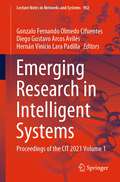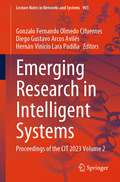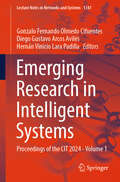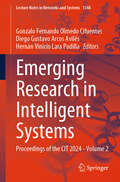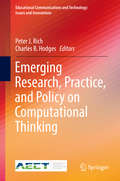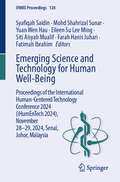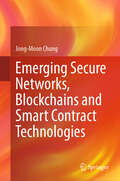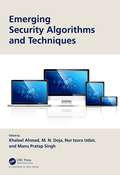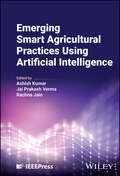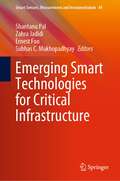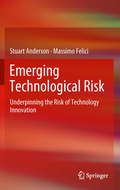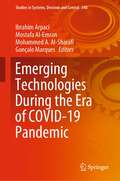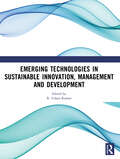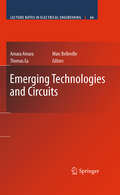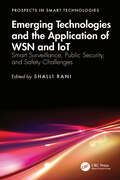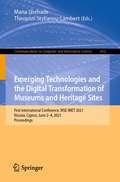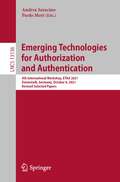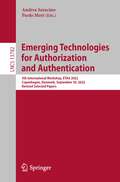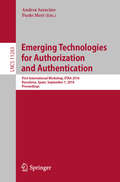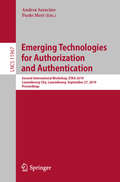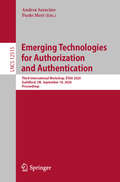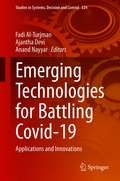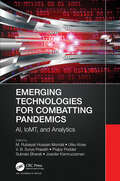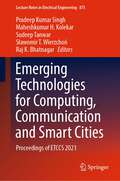- Table View
- List View
Emerging Research in Intelligent Systems: Proceedings of the CIT 2023 Volume 1 (Lecture Notes in Networks and Systems #902)
by Gonzalo Fernando Olmedo Cifuentes Diego Gustavo Arcos Avilés Hernán Vinicio Lara PadillaThis book covers different aspects of advances in research, technological development, and innovation results in artificial intelligence, computational modeling, electrical, electronics, telecommunication, data communications, defense engineering, innovation, technology and society, managing technology and sustained innovation, business development, security and cryptography, and software engineering. In addition, the volume focuses on research results focused on finding innovative solutions in intelligent systems concerning the topics mentioned above, which are developed in national and international postgraduate programs and associated research groups and networks. This book interests the industry, teachers, undergraduate and graduate students, and researchers working in intelligent systems, security and defense, and technological, human, and administrative sciences.
Emerging Research in Intelligent Systems: Proceedings of the CIT 2023 Volume 2 (Lecture Notes in Networks and Systems #903)
by Gonzalo Fernando Olmedo Cifuentes Diego Gustavo Arcos Avilés Hernán Vinicio Lara PadillaThis book covers different aspects of advances in research, technological development, and innovation results in artificial intelligence, computational modeling, electrical, electronics, telecommunication, data communications, defense engineering, innovation, technology and society, managing technology and sustained innovation, business development, security and cryptography, and software engineering. In addition, the volume focuses on research results focused on finding innovative solutions in intelligent systems concerning the topics mentioned above, which are developed in national and international postgraduate programs and associated research groups and networks. This book interests the industry, teachers, undergraduate and graduate students, and researchers working in intelligent systems, security and defense, and technological, human, and administrative sciences.
Emerging Research in Intelligent Systems: Proceedings of the CIT 2024 - Volume 1 (Lecture Notes in Networks and Systems #1347)
by Gonzalo Fernando Olmedo Cifuentes Diego Gustavo Arcos Avilés Hernán Vinicio Lara PadillaThis book presents the proceedings of the XIX International Multidisciplinary Congress on Science and Technology (CIT 2024), held virtually from October 21 to 25, 2024. It showcases cutting-edge research and innovative solutions across various disciplines, including Artificial Intelligence, Computational Modeling, Software Engineering, and Security. Additionally, it covers broader scientific domains such as Computer Science, Earth and Construction Sciences, Basic Sciences, Electrical and Electronics Engineering, Telecommunications, and Energy and Mechanical Sciences. It is designed for researchers, postgraduate students, and educators, serving as a fundamental reference for advancing knowledge, a valuable academic resource, and a practical guide for industry professionals; by fostering collaboration between academia and industry, it promotes innovation, facilitates interdisciplinary exchange, and contributes to solving global challenges in science and technology.
Emerging Research in Intelligent Systems: Proceedings of the CIT 2024 - Volume 2 (Lecture Notes in Networks and Systems #1348)
by Gonzalo Fernando Olmedo Cifuentes Diego Gustavo Arcos Avilés Hernán Vinicio Lara PadillaThis book presents the proceedings of the XIX International Multidisciplinary Congress on Science and Technology (CIT 2024), held virtually from October 21 to 25, 2024. It showcases cutting-edge research and innovative solutions across various disciplines, including Artificial Intelligence, Computational Modeling, Software Engineering, and Security. Additionally, this volume explores key areas such as Defense Engineering, Innovation, Technology and Society, Managing Technology and Sustained Innovation, and Business Development, along with broader domains like Life Sciences and Agriculture, Economic and Administrative Sciences, Human and Social Sciences, Security and Defense, and Medical Sciences. It is designed for researchers, postgraduate students, and educators, serving as a fundamental reference for advancing knowledge, a valuable academic resource, and a practical guide for industry professionals; by fostering collaboration between academia and industry, it promotes innovation, facilitates interdisciplinary exchange, and contributes to solving global challenges in science and technology.
Emerging Research, Practice, and Policy on Computational Thinking
by Peter J. Rich Charles B. HodgesThis book reports on research and practice on computational thinking and the effect it is having on education worldwide, both inside and outside of formal schooling. With coding becoming a required skill in an increasing number of national curricula (e. g. , the United Kingdom, Israel, Estonia, Finland), the ability to think computationally is quickly becoming a primary 21st century "basic" domain of knowledge. The authors of this book investigate how this skill can be taught and its resultant effects on learning throughout a student's education, from elementary school to adult learning.
Emerging Science and Technology for Human Well-Being: Proceedings of the International Human-Centered Technology Conference 2024 (iHumEnTech 2024), November 28-29, 2024, Senai, Johor, Malaysia (IFMBE Proceedings #128)
by Fatimah Ibrahim Yuan Wen Hau Syafiqah Saidin Mohd Shahrizal Sunar Eileen Su Lee Ming Siti Aisyah Mualif Farah Hanis JuhariThis book covers advances in science and technologies promoting human health and/or enhancing everyday life. It discusses new methods to improve monitoring, therapy or rehabilitation, advances in telemedicine, machine learning applications in image processing, advanced materials for drug delivery, and a wide range of issues related to human-computer interaction, AI applications, sport technologies and technology safety. Based on the International Human-Centered Conference 2024 (iHumEnTech 2024), held on November 28 - 29, 2024, in Senai, Johor, Malaysia, this book offers a timely reference for both academics and professionals in the broad field of biomedical engineering, health technology and human-technology interaction.
Emerging Secure Networks, Blockchains and Smart Contract Technologies
by Jong-Moon ChungThis book equips readers with the essential knowledge to innovate and improve network performance while ensuring security and safety. It covers foundational TCP/IP Internet network technologies and significant cyber-attack case studies. Additionally, it explains the core technologies behind Bitcoin, Ethereum, blockchains, smart contracts, hash functions, and encryption. The book also explores advanced concepts such as reinforcement learning, generative AI, federated learning, and digital twin technologies, offering new approaches to enhancing network security and blockchains through these cutting-edge methods.
Emerging Security Algorithms and Techniques
by Khaleel Ahmad Nur Izura Udzir M. N. Doja Manu Pratap SinghCyber security is the protection of information systems, hardware, software, and information as well from theft, damages, interruption or misdirection to any of these resources. In other words, cyber security focuses on protecting computers, networks, programs and data (in use, in rest, in motion) from unauthorized or unintended access, change or destruction. Therefore, strengthening the security and resilience of cyberspace has become a vital homeland security mission. Cyber security attacks are growing exponentially. Security specialists must occupy in the lab, concocting new schemes to preserve the resources and to control any new attacks. Therefore, there are various emerging algorithms and techniques viz. DES, AES, IDEA, WAKE, CAST5, Serpent Algorithm, Chaos-Based Cryptography McEliece, Niederreiter, NTRU, Goldreich–Goldwasser–Halevi, Identity Based Encryption, and Attribute Based Encryption. There are numerous applications of security algorithms like cyber security, web security, e-commerce, database security, smart card technology, mobile security, cloud security, digital signature, etc. The book offers comprehensive coverage of the most essential topics, including: Modular Arithmetic, Finite Fields Prime Number, DLP, Integer Factorization Problem Symmetric Cryptography Asymmetric Cryptography Post-Quantum Cryptography Identity Based Encryption Attribute Based Encryption Key Management Entity Authentication, Message Authentication Digital Signatures Hands-On "SageMath" This book serves as a textbook/reference book for UG, PG, PhD students, Teachers, Researchers and Engineers in the disciplines of Information Technology, Computer Science and Engineering, and Electronics and Communication Engineering.
Emerging Smart Agricultural Practices Using Artificial Intelligence
by Ashish Kumar Rachna Jain Jai Prakash VermaBring the latest technology to bear in the fight for sustainable agriculture with this timely volume Artificial intelligence (AI) has the potential to revolutionize virtually every area of research and scientific practice, including agriculture. With AI solutions emerging to drive higher yields, produce increased resource efficiency, and foster sustainability, there is an urgent need for a volume outlining this progress and charting its future course. Emerging Smart Agricultural Practices Using Artificial Intelligence meets this need with a deep dive into the rapidly developing intersection of agriculture and artificial intelligence. Taking an interdisciplinary approach which applies data science, computer science, and engineering techniques, the book provides cutting-edge insights on the latest advancements in AI-driven agricultural practices. The result is an absolutely critical tool in the ongoing fight to develop sustainable world agriculture. In addition, this book provides: Case studies and real-world applications of new techniques throughoutDetailed discussion of agricultural applications for AI-driven technologies such as machine learning, computer vision, and data analytics A regional approach showcasing international best practices and addressing the varying needs of farmers worldwide Emerging Smart Agricultural Practices Using Artificial Intelligence is ideal for agricultural professionals and scientists, as well as data scientists, technologists, and agricultural policymakers.
Emerging Smart Technologies for Critical Infrastructure (Smart Sensors, Measurement and Instrumentation #44)
by Subhas C. Mukhopadhyay Ernest Foo Shantanu Pal Zahra JadidiThis book highlights the latest advancements, innovation, technology, and real-world challenges and solutions related to smart critical infrastructure. In addition, it provides quantitative and qualitative research innovations to individual, academic, organizational and industry practitioners in a wide range of practical solutions using emerging technologies in areas such as smart sensing, data acquisition, data analytics, data processing, and other related topics, such as security, privacy, and trust to devices, users, and the systems. Finally, the book discusses the various societal applications using the Internet of Things and emerging technologies. As such, it offers an essential reference guide about the latest design and development in critical infrastructure for academia and industry. Fully explaining all the techniques used, the book is of interest to engineers, researchers, and scientists working in wireless sensor networks, Internet of Things systems, and emerging technologies.
Emerging Technological Risk
by Massimo Felici Stuart AndersonClasses of socio-technical hazards allow a characterization of the risk in technology innovation and clarify the mechanisms underpinning emergent technological risk. Emerging Technological Risk provides an interdisciplinary account of risk in socio-technical systems including hazards which highlight: · How technological risk crosses organizational boundaries, · How technological trajectories and evolution develop from resolving tensions emerging between social aspects of organisations and technologies and · How social behaviour shapes, and is shaped by, technology. Addressing an audience from a range of academic and professional backgrounds, Emerging Technological Risk is a key source for those who wish to benefit from a detail and methodical exposure to multiple perspectives on technological risk. By providing a synthesis of recent work on risk that captures the complex mechanisms that characterize the emergence of risk in technology innovation, Emerging Technological Risk bridges contributions from many disciplines in order to sustain a fruitful debate. Emerging Technological Risk is one of a series of books developed by the Dependability Interdisciplinary Research Collaboration funded by the UK Engineering and Physical Sciences Research Council.
Emerging Technologies During the Era of COVID-19 Pandemic (Studies in Systems, Decision and Control #348)
by Mostafa Al-Emran Gonçalo Marques Ibrahim Arpaci Mohammed A. Al-SharafiThis book tackles the recent research directions in using the newly emerged technologies during the era of COVID-19 pandemic. It mainly focuses on using emerging technologies and their impact on health care, education, and society. It also provides insights into the current challenges and constraints in using technologies during the era of COVID-19 pandemic and exposes new opportunities for future research in the domain.
Emerging Technologies In Sustainable Innovation, Management and Development
by R. UdayakumarICETSIMD 2025 was conceived as a vital platform for academicians, researchers, and industry leaders. Its primary purpose was to explore the transformative potential of emerging technologies in driving sustainable development. To ensure the high quality, originality, and relevance of the contributions, all submissions to the ICETSIMD 2025 confer□ence underwent a rigorous double-blind peer review process.We received 300 manuscript submissions, from which 100 were selected for inclusion in the conference proceedings. Each manuscript was evaluated by at least two independent experts based on criteria including scientific rigor, methodological soundness, clarity, and contribution to the conference themes.
Emerging Technologies and Circuits
by Marc Belleville Amara Amara Thomas EaWith the semiconductor market growth, new Integrated Circuit designs are pushing the limit of the technology and in some cases, require specific fine-tuning of certain process modules in manufacturing. Thus the communities of design and technology are increasingly intertwined. The issues that require close interactions and collaboration for trade-off and optimization across the design/device/process fields are addressed in Emerging Technologies and Circuits. It contains a set of outstanding papers, keynote and tutorials presented during 3 days at the International Conference On Integrated Circuit Design and Technology (ICICDT) held in June 2008 in Minatec, Grenoble. The selected papers are spread over 5 chapters covering various aspects of emerging technologies and devices, advanced circuit design, reliability, variability issues and solutions, advanced memories and analog and mixed signals. All these papers are focusing on design and technology interactions and comply with the scope of the conference.
Emerging Technologies and Pedagogies in the Curriculum (Bridging Human and Machine: Future Education with Intelligence)
by Mohamed Ally Shengquan Yu Avgoustos TsinakosThis book explores the technologies that can be used in curricula to make education “smarter” and more adaptive in order to better meet the needs of today’s learners. The main emphasis is based on the theory and best practices of incorporating emerging technologies into curricula so as to educate learners in the 21st century. The book provides valuable insights into the future of education and examines which pedagogies are most suitable for integrating emerging technologies. It will help educators and stakeholders design and implement curricula that effectively prepare learners for the challenges of tomorrow.
Emerging Technologies and the Application of WSN and IoT: Smart Surveillance, Public Security, and Safety Challenges (Prospects in Smart Technologies)
by Shalli RaniThe Internet of Things (IoT) has numerous applications, including smart cities, industries, cloud-based apps, smart homes, and surveillance.The Internet of Things (IoT) enables smarter living by connecting devices, people, and objects. As networking became a crucial aspect of the Internet, rigorous design analysis led to the development of new research areas.The Internet of Things has revolutionized daily living in countless ways. It enables communication between buildings, people, portable gadgets, and vehicles, facilitating mobility. Smart cities and cloud-based data have transformed corporate practices. With billions of connected gadgets, everything will soon be able to communicate remotely. IoT networks, whether public or private, rely significantly on machine learning and software-defined networking. Indian and other governments have approved various research projects on IoT-based networking technologies. This field of study will significantly impact society in the future.Researchers are concerned about the many application areas and driving forces behind smart cities. The authors aim to provide insights into software-defined networking, artificial intelligence, and machine learning technologies used in IoT and networking. The framework focuses on practical applications and infrastructures. The book includes practical challenges, case studies, innovative concepts, and other factors that impact the development of realistic scenarios for smart surveillance. It also highlights innovative technology, designs, and algorithms that can accelerate the creation of smart city concepts.This resource includes real-world applications and case studies for smart city technology, enormous data management, and machine learning prediction, all with confidentiality and safety problems.
Emerging Technologies and the Digital Transformation of Museums and Heritage Sites: First International Conference, RISE IMET 2021, Nicosia, Cyprus, June 2–4, 2021, Proceedings (Communications in Computer and Information Science #1432)
by Theopisti Stylianou-Lambert Maria ShehadeThis book constitutes the post-conference proceedings of the First International Conference on Emerging Technologies and the Digital Transformation of Museums and Heritage Sites, RISE IMET 2020, held in Nicosia, Cyprus, in June 2021*.The 23 revised full papers were carefully reviewed and selected from 38 submissions. The papers are organized in the following topical sections: digital curation and visitor engagement in museums and heritage sites; VR, AR, MR, mobile applications and gamification in museums and heritage sites; digital storytelling and embodied characters for the interpretation of cultural heritage; emerging technologies, difficult heritage and affective practices; participatory approaches, crowdsourcing and new technologies; digitization, documentation and digital representation of cultural heritage.* The conference was held virtually due to the COVID-19 pandemic.
Emerging Technologies for Authorization and Authentication: 4th International Workshop, ETAA 2021, Darmstadt, Germany, October 8, 2021, Revised Selected Papers (Lecture Notes in Computer Science #13136)
by Paolo Mori Andrea SaracinoThis book constitutes the proceedings of the 4th International Workshop on Emerging Technologies for Authorization and Authentication, ETAA 2021, held in Darmstadt, Germany, on October 8, 2021. The workshop was co-located with ESORICS 2021. The 11 full papers presented in this volume were carefully reviewed and selected from 14 submissions. The workshop presents new techniques for biometric and behavioral based authentication, authentication and authorization in the IoT and in distributed systems in general, including smart home environment.
Emerging Technologies for Authorization and Authentication: 5th International Workshop, ETAA 2022, Copenhagen, Denmark, September 30, 2022, Revised Selected Papers (Lecture Notes in Computer Science #13782)
by Paolo Mori Andrea SaracinoThis volume constitutes the refereed proceedings of the 5th International Workshop on Emerging Technologies for Authorization and Authentication, ETAA 2022, held in Copenhagen, Denmark, on September 30, 2022, co-located with ESORICS 2022.The revised 8 full papers presented together with one invited paper were carefully reviewed and selected from 10 submissions. They cover topics such as: new techniques for biometric and behavioral based authentication, authentication and authorization in the IoT and in distributed systems in general, including the smart home environment.
Emerging Technologies for Authorization and Authentication: First International Workshop, ETAA 2018, Barcelona, Spain, September 7, 2018, Proceedings (Lecture Notes in Computer Science #11263)
by Paolo Mori Andrea SaracinoThis book constitutes the proceedings of the First International Workshop on Emerging Technologies for Authorization and Authentication, ETAA 2018, held in Barcelona, Spain, in September 2018. The 10 papers presented in this volume were carefully reviewed and selected from 16 submissions. They were organized in two parts: authentication and authorization techniques and violation detection and countermeasures.
Emerging Technologies for Authorization and Authentication: Second International Workshop, ETAA 2019, Luxembourg City, Luxembourg, September 27, 2019, Proceedings (Lecture Notes in Computer Science #11967)
by Paolo Mori Andrea SaracinoThis book constitutes the proceedings of the Second International Workshop on Emerging Technologies for Authorization and Authentication, ETAA 2019, held in Luxembourg, in September 2019. The 10 full papers presented in this volume were carefully reviewed and selected from numerous submissions. They focus on new techniques for biometric and behavioral based authentication, authentication and authorization in the IoT and in distributed systems in general, techniques for strengthen password based authentication and for dissuading malicious users from stolen password reuse, an approach for discovering authentication vulnerabilities in interconnected accounts, and strategies to optimize the access control decision process in the Big Data scenario.
Emerging Technologies for Authorization and Authentication: Third International Workshop, ETAA 2020, Guildford, UK, September 18, 2020, Proceedings (Lecture Notes in Computer Science #12515)
by Paolo Mori Andrea SaracinoThis book constitutes the proceedings of the Third International Workshop on Emerging Technologies for Authorization and Authentication, ETAA 2020, held in Guildford, UK, in September 2020. The 10 full papers presented in this volume were carefully reviewed and selected from 15 submissions. The conference was planned at University of Surrey, Guildford, UK. Due to COVID-19 outbreak, ESORICS conference and affiliated workshop will be held online. The workshop presents new techniques for biometric and behavioral based authentication, and authorization in the IoT and in distributed systems in general, and much more.
Emerging Technologies for Battling Covid-19: Applications and Innovations (Studies in Systems, Decision and Control #324)
by Fadi Al-Turjman Anand Nayyar Ajantha DeviThe book presents recent trends and solutions to help healthcare sectors and medical staff protect themselves and others and limit the spread of the COVID-19. The book also presents the problems and challenges researchers and academics face in tackling this monumental task. Topics include: Unmanned Aerial Vehicle (UAV) or drones that can be used to detect infected people in different areas; robots used in fighting the COVID-19 by protecting workers and staff dealing with infected people; blockchain technology that secures sensitive transactions in strict confidentiality. With contributions from experts from around the world, this book aims to help those creating and honing technology to help with this global threat.
Emerging Technologies for Combatting Pandemics: AI, IoMT, and Analytics
by Mondal, M. Rubaiyat HossainThe COVID-19 pandemic has significantly affected the healthcare sector across the globe. Artificial Intelligence (AI) and the Internet of Medical Things (IoMT) play important roles when dealing with emerging challenges. These technologies are being applied to problems involving the early detection of infections, fast contact tracing, decision-making models, risk profiling of cohorts, and remote treatment. Applying these technologies runs against challenges including interoperability, lack of unified structure for eHealth, and data privacy and security. Emerging Technologies for Combatting Pandemics: AI, IoMT, and Analytics examines multiple models and solutions for various settings including individual, home, work, and society. The world’s healthcare systems are battling the novel coronavirus, and government authorities, scientists, medical practitioners, and medical services are striving hard to surmount these challenges. This book focuses on the design and implementation of AI-based approaches in the proposed COVID-19 solutions that are enabled and supported by IoMT, sensor networks, cloud and edge computing, robotics, and analytics. It covers technologies under the umbrella of AI that include data science, big data, machine learning (ML), semantic technologies, analytics, and cyber security. Highlights of the book include: Epidemic forecasting models Surveillance and tracking systems IoMT and Internet of Healthcare Things-based integrated systems for COVID-19 Social network analysis systems Radiological image- based diagnosis systems Computational intelligence methods This reference work is beneficial for interdisciplinary students, researchers, and healthcare and technology professionals who need to know how computational intelligence could be used for surveillance, control, prevention, prediction, diagnosis, and potential treatment of the disease.
Emerging Technologies for Computing, Communication and Smart Cities: Proceedings of ETCCS 2021 (Lecture Notes in Electrical Engineering #875)
by Pradeep Kumar Singh Maheshkumar H. Kolekar Sudeep Tanwar Raj K. Bhatnagar Sławomir T. WierzchońThis book presents best selected papers presented at the Second International Conference on Emerging Technologies for Computing, Communication and Smart Cities (ETCCS 2021) held on 21-22 August 2021 at BFCET, Punjab, India. IEI India members supported externally. It is co-organized by Southern Federal University, Russia; University of Jan Wyżykowski (UJW), Polkowice, Poland, SD College of Engineering & Technology, Muzaffarnagar Nagar, India as an academic partner and CSI, India for technical support. The book includes current research works in the areas of network and computing technologies, wireless networks and Internet of things (IoT), futuristic computing technologies, communication technologies, security and privacy.
